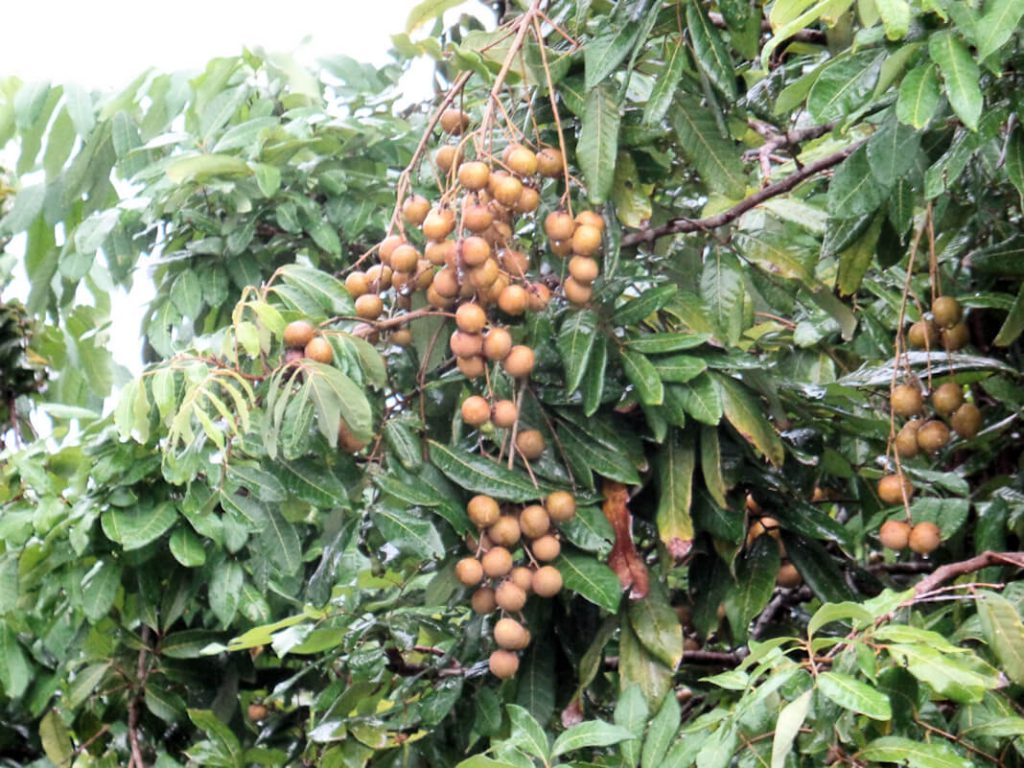
The longan tree is one of the few fruit trees producing a crop in August, so the small brown fruit are a welcome seasonal taste treat. A family member of the lychee, the longan tree is an attractive evergreen all by itself – the fruit is just an added bonus! Best grown in the warmer parts of Charlotte County or in noted microclimates, the longan may be something to try.
Originating in Southeast Asia, the longan reached our country in 1903 and has been a commercial crop in south Florida since the 1990’s. It is well adapted to the subtropics where there is a period of cool, but not freezing winters, and dry periods in the fall and winter. Because of weather conditions, longan trees may not bear fruit every year. In a good year, a mature tree can produce over fifty pounds of fruit. The twelve-inch-long evergreen leaves are shiny and dark green in color, while the greenish-yellow flowers are small and arranged in clusters called panicles. The clusters of fruit that develop are round to oval and around an inch in diameter. The fruit reminds me of a small potato in appearance with a brown leathery covering surrounding the white pulp containing a dark brown seed. The pulp is sweet and has a unique, delicious flavor. Keep in mind that it takes over one-hundred and forty days to go from flower to ready-to-eat fruit.
Once established in a full sun site, the longan is very drought tolerant, but does not take flooding well – well-drained soils only. The longan also does not like salty conditions which will cause leaf burn and general dieback. As mentioned, the longan can take our subtropical climate for the most part, but can be damaged or killed when temperatures approach twenty-seven degrees F. Growing unpruned upwards to thirty-feet tall, it should be trained to maintain a height of about fifteen feet tall.
For best quality, consider thinning the number of fruit. By reducing about fifty percent of the fruit set when they are about one-quarter of an inch in the spring, each remaining fruit will be significantly bigger and more appealing. This will help individual fruit approach the desired one and one-quarter of an inch (or bigger) diameter size which will have the most flesh and the best flavor. Test a few fruits for taste before you harvest the entire cluster. Longan fruit can be stored in a plastic bag in a refrigerator for up to seven days.
Most garden centers regularly carry longan trees for sale. In Florida, the number one cultivar planted is ‘Kohala’. This has been found to be the best variety and is recommended for backyard plantings. The biggest pest likely encountered will be birds and squirrels eating the ripe fruit. Bird netting works well to exclude these vertebrate pests and protect the crop. One good news item – unlike lychee, longan trees do not suffer from the dreaded lychee mite devastating our local lychees.
If you are looking for an interesting fruit tree to try, the longan might be a good choice for you. Try the fruit ahead of time by visiting tropical fruit growers in August to sample some of these tasty morsels! For more information on all types of fruit to grow in our area, or to ask a question, please visit https://www.facebook.com/CharlotteMGLifeline/ . Ralph E. Mitchell is the Director/Horticulture Agent for the UF/IFAS Charlotte County Extension Service. He can be reached at 941-764-4344 or ralph.mitchell@charlottecountyfl.gov.
Resource: Crane, J. H., Balerdi, C. F., Sargent, S. A. & Maguire, I. (2019) Longan Growing in the Florida Home Landscape. The University of Florida Extension Service, IFAS.
 1
1
